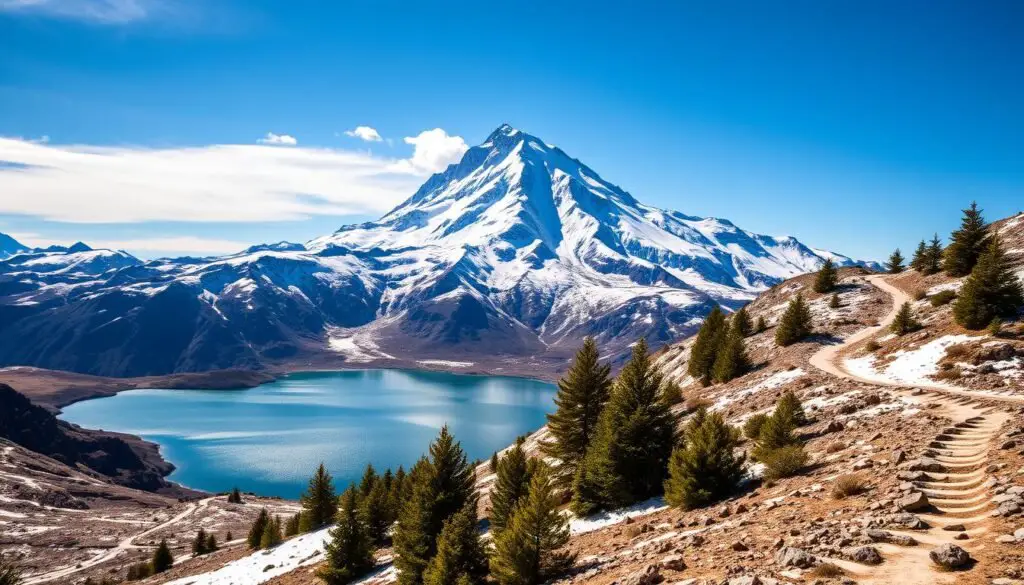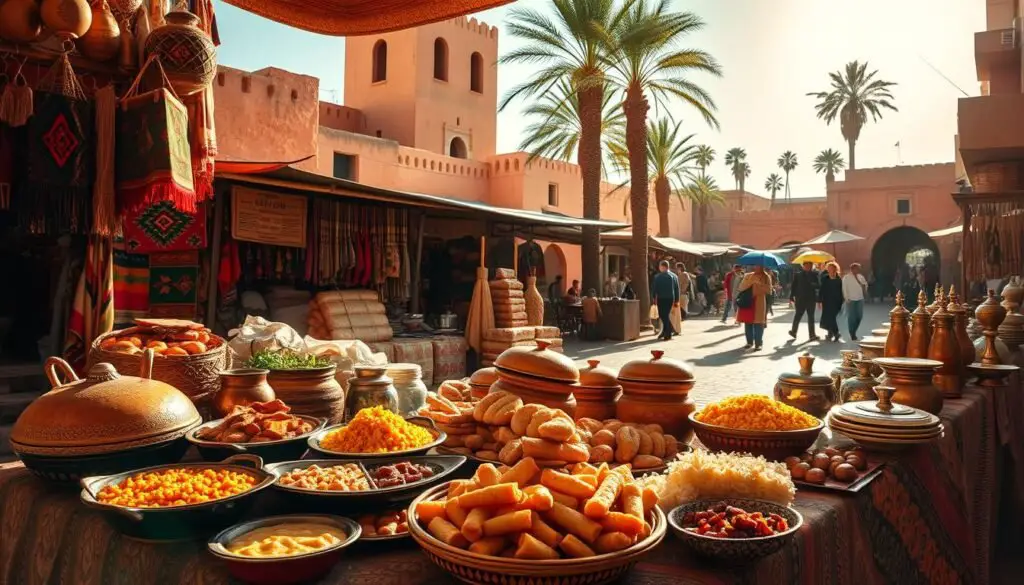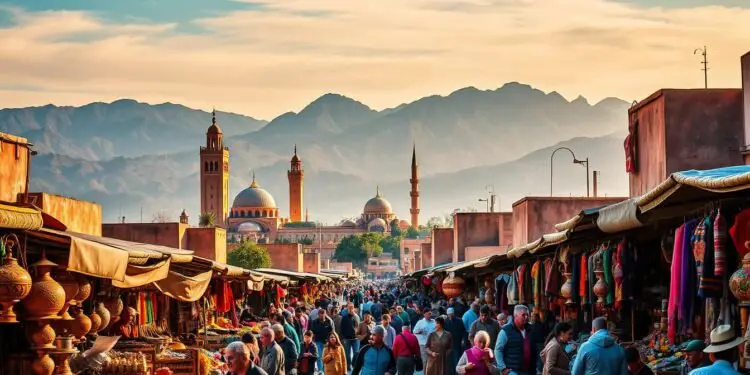Have you ever wondered what makes Morocco a unique destination that bridges continents and centuries? This North African gem is a vibrant blend of Arab, Berber, and European influences, offering a cultural experience like no other.
From the bustling medinas of Fes to the serene Sahara Desert, Morocco is a land of contrasts. Its imperial cities, UNESCO World Heritage Sites, and breathtaking landscapes like the Atlas Mountains make it a top choice for explorers and adventurers.
Recent efforts in 2023 highlight the country’s commitment to preserving its rich history and traditions. Whether you’re wandering through ancient souks or sharing tea with local Berber communities, every moment here feels authentic and timeless.
Key Takeaways
- Morocco blends Arab, Berber, and European influences.
- Imperial cities and UNESCO sites are must-visit destinations.
- The Sahara Desert and Atlas Mountains offer stunning landscapes.
- Authentic experiences with local Berber communities are unforgettable.
- Cultural preservation efforts are ongoing as of 2023.
Morocco’s Rich Cultural Traditions
The heart of Moroccan culture lies in its rituals and shared experiences. From the ceremonial preparation of mint tea to the communal joy of shared meals, these traditions reflect the country’s warmth and hospitality.
The Art of Moroccan Mint Tea
Moroccan mint tea is more than just a drink; it’s a symbol of hospitality. Prepared with fresh spearmint, green tea, and sugar, this sweet beverage is served in small glasses. The male head of the family often performs the ceremonial pouring, offering three or more glasses to guests as a gesture of welcome.
This tea ritual is a cornerstone of social interactions, whether with family, friends, or business associates. It’s a moment to connect, share stories, and build relationships.
Dining Etiquette and Shared Meals
Moroccan dining is a communal experience that brings people together. Meals often feature dishes like tagine, prepared with fresh ingredients from local markets. Bread replaces utensils, and olive oil is a staple, highlighting the simplicity and richness of Moroccan food.
Etiquette plays a key role. Using the right hand for eating is mandatory, as the left hand is considered unclean. This practice reflects respect and cultural values. Shared dinners, often held late, strengthen bonds between generations and create lasting memories.
In Moroccan culture, the liver symbolizes love. Expressions like “my liver” are terms of endearment, showcasing the depth of emotional connections. These traditions, from tea to meals, highlight the importance of togetherness in Moroccan life.
Historical Marvels of Morocco
Morocco’s history is a tapestry of ancient traditions and modern influences. From the oldest university in the world to a royal dynasty that has ruled for centuries, the country’s past is as vibrant as its present.
The World’s Oldest University
Founded in 859 AD by Fatima al-Fihri, the University of al-Kairaouine in Fez holds the title of the oldest university still in operation. Initially established as a mosque, it became a center for Islamic learning, attracting scholars from across the world.
Its medieval curriculum focused on Islamic studies, astronomy, and languages. Today, it blends traditional teachings with modern education, preserving its legacy while adapting to the 21st century.
Morocco’s Ancient Ruling Dynasty
The Aloui Dynasty, ruling since 1631, claims descent from the Prophet Muhammad. King Mohammed VI, the 23rd monarch, continues this legacy. The dynasty has shaped Morocco’s history, navigating challenges like the French protectorate from 1912 to 1956.
This period influenced urban development, with Rabat becoming the administrative capital. Today, Throne Day on July 30 celebrates the monarchy, honoring its role in unifying the nation.
Another iconic landmark is the Hassan II Mosque in Casablanca. Its 210-meter minaret, adorned with laser beams pointing toward Mecca, symbolizes Morocco’s architectural grandeur and spiritual devotion.
Fascinating Geography and Landscapes
From snow-capped mountains to golden dunes, Morocco’s geography is diverse and stunning. The country’s landscapes are a blend of rugged peaks and vast deserts, offering unforgettable experiences for travelers.
The High Atlas Mountains
The High Atlas Mountains stretch over 1,000 kilometers, with Jebel Toubkal standing as the highest peak in North Africa at 13,672 feet. Known as “Idraren Draren” in Berber, meaning “Mountains of Mountains,” this range is a haven for trekkers and nature lovers.
Berber villages dot the mountains, preserving ancient traditions and offering a glimpse into rural life. The Oukaimeden ski resort, located at elevations between 8,500 and 10,500 feet, is a unique destination for winter sports enthusiasts.
Toubkal National Park is a must-visit, with trails that showcase the region’s stunning biodiversity. However, climate change poses challenges to these fragile ecosystems, making conservation efforts crucial.
The Sahara Desert’s Magic
The Sahara Desert is a land of endless dunes and star-filled skies. Erg Chebbi’s golden sands have been featured in films like “Gladiator” and “Game of Thrones,” highlighting their cinematic beauty.
Camping under the stars in the desert is an unforgettable experience. Visitors can explore UNESCO-listed sites like Aït Benhaddou, a historic kasbah that has served as a backdrop for numerous Hollywood productions.
The contrast between the snow-capped mountains and the scorching desert heat showcases Morocco’s diverse landscapes. Whether trekking through the High Atlas or riding camels in the Sahara, every journey here is an adventure.
Interesting Facts of Morocco: Unique Highlights
From towering peaks to vibrant cities, Morocco’s highlights captivate travelers. This North African gem offers a mix of natural wonders and cultural treasures that leave a lasting impression.
Africa’s Highest Ski Resort
Nestled in the High Atlas Mountains, Oukaimeden stands as Africa’s highest ski resort. At over 10,000 feet, it boasts 20 ski slopes and a single access road, making it a unique winter destination.
Ski lift operations here are a marvel, offering breathtaking views of the Atlas Mountains. The best time to visit is between December and March, when snow blankets the slopes. Combining a ski trip with a desert adventure is a popular itinerary for visitors.

The “Red City” of Marrakech
Marrakech, known as the Red City, is a visual feast. Its iconic red clay buildings date back to the Almohad Dynasty, reflecting a historical ordinance that mandated this unique color scheme.
Jemaa el-Fna square, founded in 1062, is the heart of the city. By day, it’s a bustling market filled with vendors and performers. By night, it transforms into a lively hub of food stalls and entertainment.
From rooftop terraces, visitors can enjoy stunning views of the High Atlas. However, rapid urban growth poses challenges to preserving the historic medinas, making conservation efforts essential.
Morocco’s Imperial Cities and Capitals
Step into the heart of Morocco’s imperial cities and uncover their stories. These historic hubs are a blend of ancient traditions and modern life, offering a glimpse into the country’s rich heritage. From Fez’s labyrinthine alleys to Rabat’s modern government quarter, each city tells a unique tale.
Fez: The Car-Free Medina
Fez, one of Morocco’s oldest cities, is home to a UNESCO-listed medina that dates back to the 9th century. With over 10,000 alleys, it’s a maze of history and culture. Transportation here relies on donkeys and horses, preserving its timeless charm.
The medina’s iconic tanneries, where leather is dyed using traditional methods, are a must-see. Al Quaraouiyine University, the world’s oldest continuously operating university, adds to Fez’s cultural significance. Walking through its narrow streets feels like stepping back in time.
Rabat: Modern Capital with Historic Roots
Rabat, Morocco’s capital, seamlessly blends modernity with history. The city’s government quarter contrasts with ancient sites like the 12th-century Hassan Tower. This UNESCO World Heritage Site is a testament to Rabat’s enduring legacy.
The Chellah Necropolis and Kasbah of the Oudaya showcase Andalusian influences, with blue-walled alleys and lush gardens. Rabat’s development from a medieval foundation to a modern hub reflects Morocco’s ability to honor its past while embracing the future.
Moroccan Food and Exports
Moroccan cuisine is a vibrant blend of flavors and traditions, celebrated both locally and globally. From the sweet richness of dates to the golden allure of argan oil, the country’s exports are as diverse as its culture. These products not only define Moroccan food but also play a significant role in its economy.

Dates and Argan Oil: Global Treasures
Dates are a staple in Moroccan cuisine, with the Draa Valley being a key cultivation hub. The country exports over 9,000 tons annually, showcasing its expertise in sustainable farming. These sweet fruits are often enjoyed during festive meals, symbolizing hospitality and abundance.
Argan oil, known as “liquid gold,” is another prized export. Extracted by women’s cooperatives, 80% of it is used in cosmetics, while 20% enhances culinary dishes. Its production supports local communities and preserves traditional methods, making it a symbol of Moroccan heritage.
The Symbolism of Love in Cuisine
Moroccan food often carries deep cultural meanings. Dishes like b’stilla pie, with its layers of flavors, symbolize love and celebration. The phrase “my liver” is a term of endearment, reflecting the emotional connection Moroccans have with their cuisine.
In markets and souks, bargaining is a ritual that strengthens bonds between buyers and sellers. Using the left hand for eating is avoided, as it’s considered unclean, showcasing the importance of respect in dining etiquette.
French culinary influences are also evident, especially in patisserie and café culture. This blend of traditions makes Moroccan food a unique experience, celebrated worldwide.
Conclusion
Morocco stands as a captivating destination where ancient traditions meet modern allure. Its unique blend of historic landmarks and vibrant cities makes it a must-visit for travelers. From the Atlas Mountains to the Sahara Desert, the country offers diverse itineraries that cater to every adventurer.
Responsible tourism plays a key role in supporting local communities. Engaging with Berber culture has become more accessible, allowing visitors to connect deeply with the people and their traditions. Awareness of cultural etiquette ensures a respectful and enriching experience.
For first-time visitors, a 7-10 day trip is ideal to explore the highlights. Off-season travel offers unique opportunities to witness festivals and events. With its growing infrastructure, Morocco is also becoming a hub for digital nomads, making it a home away from home for extended stays.
Thanks to its rich heritage and welcoming spirit, Morocco continues to captivate the world. Whether you’re planning a short visit or a longer stay, this North African gem promises unforgettable memories.
FAQ
What makes Moroccan mint tea unique?
Moroccan mint tea is a symbol of hospitality. It’s made with green tea, fresh mint leaves, and sugar, served in ornate teapots and poured from a height to create foam.
What is the significance of shared meals in Morocco?
Shared meals reflect Moroccan culture’s emphasis on community. Families and friends gather around a communal dish, often using bread instead of utensils to eat.
Where is the world’s oldest university located?
The University of Al Quaraouiyine in Fez, founded in 859 AD, is recognized as the oldest continuously operating university in the world.
What is special about the High Atlas Mountains?
The High Atlas Mountains are home to North Africa’s highest peak, Mount Toubkal, and offer stunning landscapes, traditional Berber villages, and trekking opportunities.
Why is Marrakech called the "Red City"?
Marrakech is known as the “Red City” due to the reddish sandstone used in its historic buildings, giving the city a distinctive warm hue.
What makes Fez’s Medina unique?
Fez’s Medina is one of the largest car-free urban areas in the world, featuring narrow alleys, bustling souks, and historic landmarks like the tanneries.
What are Morocco’s most famous exports?
Morocco is renowned for its dates and argan oil, both of which are prized globally for their nutritional and cosmetic benefits.
What is the cultural significance of dates in Moroccan cuisine?
Dates are a symbol of love and hospitality, often served to guests or used in traditional dishes and desserts during special occasions.




